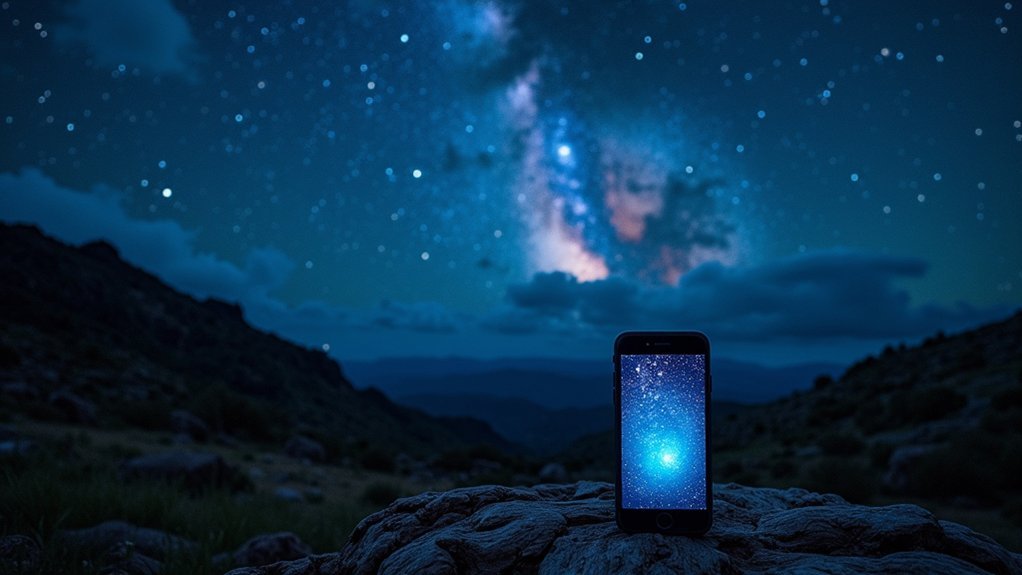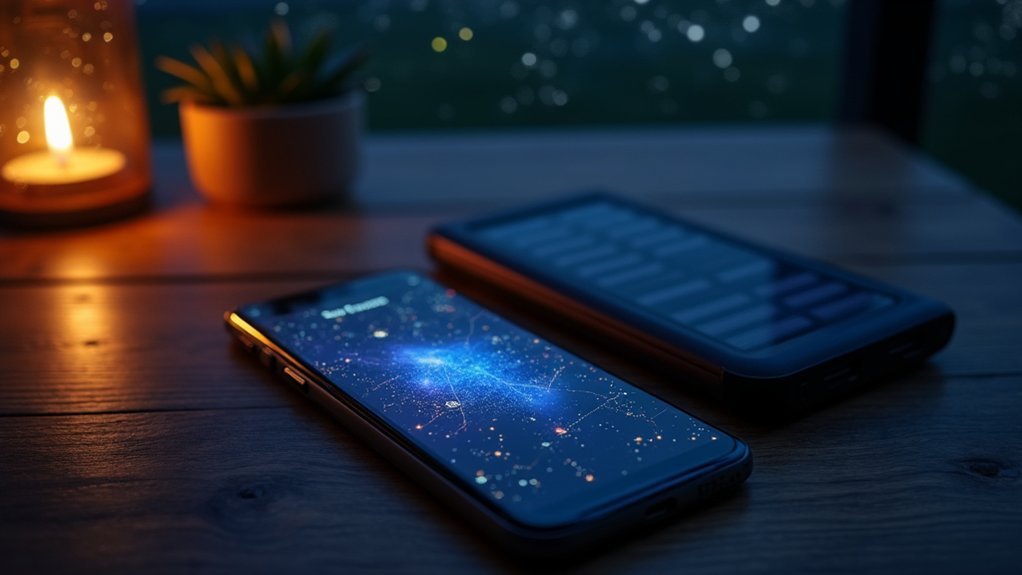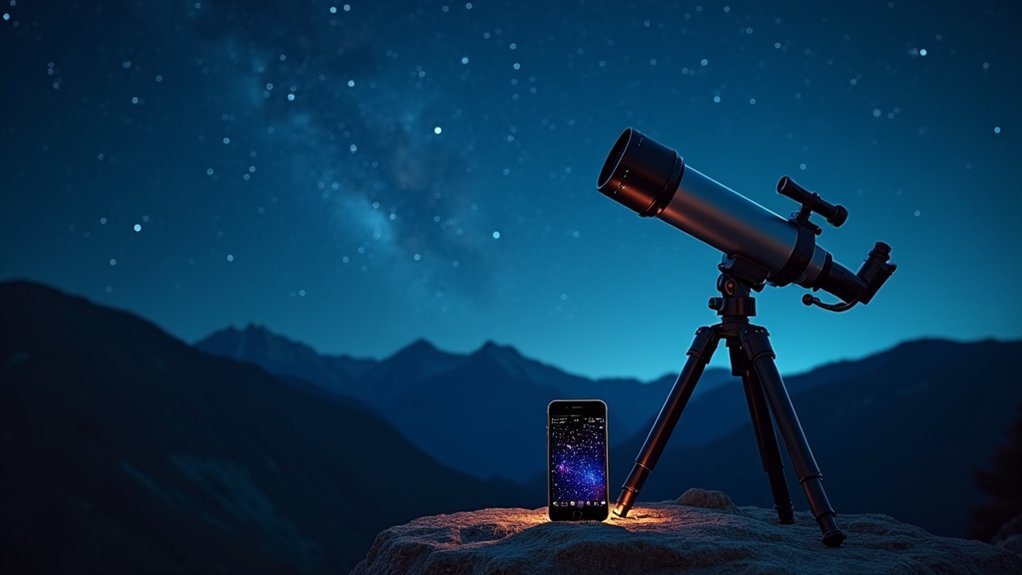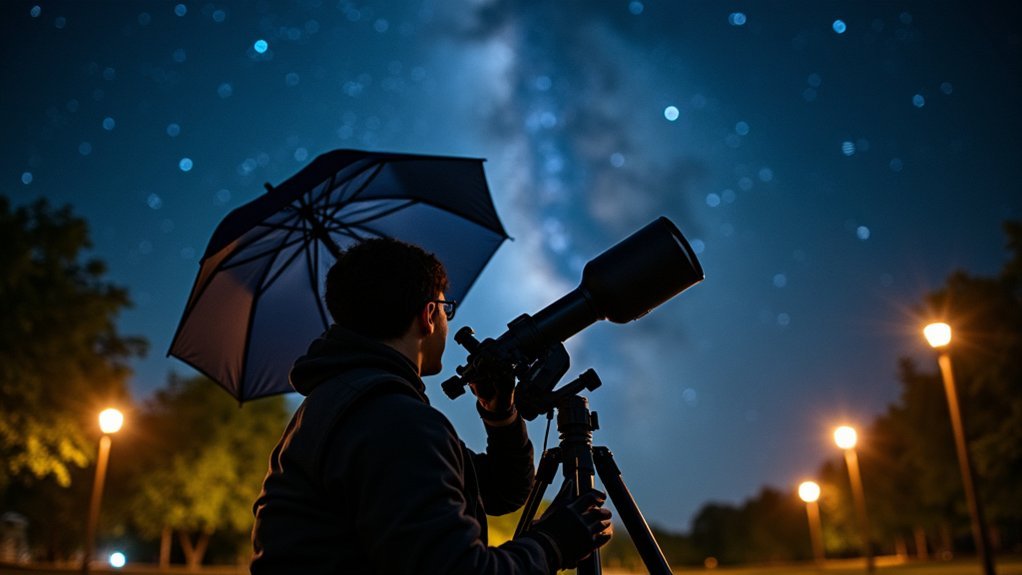Several free stargazing apps work perfectly without internet connection. SkyView Lite offers complete offline functionality with no GPS required, while Sky Guide provides intuitive constellation maps you can access anywhere. Star Walk 2 includes a helpful “visible tonight” section and night mode for outdoor viewing. These apps use your device’s sensors to identify celestial objects through augmented reality interfaces. Prepare for your next adventure by downloading star maps before heading to remote observation locations.
Top Offline-Compatible Stargazing Apps for Beginners

When you’re far from cellular service but still want to explore the night sky, offline stargazing apps become essential companions for your astronomical adventures. SkyView Lite stands out as a completely free option that works without Wi-Fi or GPS—perfect for remote stargazing sessions.
Beginners will appreciate Sky Guide’s free version, which provides intuitive constellation maps offline.
Sky Guide’s free version offers beginners user-friendly constellation maps that work perfectly without an internet connection.
Star Walk 2 offers a helpful “visible tonight” section and night mode to protect your vision while observing celestial objects.
Though primarily paid, SkySafari 7 Plus delivers extensive offline features after downloading.
For tracking celestial events, SkyView lets you set reminders and access detailed information even without internet.
Each app helps you identify stars, planets, and constellations with minimal setup, making your offline stargazing experience both educational and enjoyable.
Essential Features of Internet-Free Astronomy Software
When exploring the night sky through offline astronomy apps, you’ll need software that continues functioning without internet connectivity and provides accurate celestial identification.
Apps like SkyView Lite and Sky Guide excel by offering complete star maps, constellation identification, and celestial body tracking without requiring data access.
The best internet-free astronomy tools also include intuitive navigation systems that let you point your device skyward to identify objects, regardless of your remote location or connectivity status.
Core Offline Functionality
Although internet connectivity enhances many mobile applications, truly effective stargazing apps must function reliably without a network connection. Free options like SkyView Lite and Sky Guide offer robust offline functionality that’s perfect for remote viewing locations where cell service is nonexistent.
The most essential offline capabilities include:
- Augmented reality interfaces that identify celestial objects when you simply point your device skyward, functioning completely without Wi-Fi or GPS.
- Comprehensive databases containing stars, planets, and constellations, ensuring you have access to essential information regardless of connectivity.
- Advanced planning tools like celestial event reminders and time-travel capabilities that let you view past and future sky configurations.
These features transform your smartphone into a powerful astronomy tool that works anywhere, from city parks to remote wilderness areas.
Navigation Without Connection
Despite being disconnected from online resources, today’s free stargazing apps offer sophisticated navigation capabilities that transform your smartphone into a pocket planetarium.
SkyView Lite uses augmented reality to locate celestial objects without requiring Wi-Fi or GPS—perfect for backcountry stargazing adventures.
Star Walk 2 provides offline access to thousands of celestial objects and delivers a location-filtered view of nightscape events.
Similarly, SkySafari 7 Plus maintains full functionality of its AR-enabled sky map without internet access, letting you explore an extensive database anywhere.
For historical perspective, SkyView’s time-travel feature allows you to observe past or future celestial positions while offline.
These stargazing apps excel at navigation without connection, enabling you to identify constellations, planets, and stars using just your device’s internal sensors and pre-downloaded sky maps.
How to Download Celestial Data for Off-Grid Exploration

To prepare your stargazing app for off-grid adventures, you’ll need to download the necessary celestial data while connected to Wi-Fi by accessing your app’s download settings and selecting the star catalogs you want available offline.
Be mindful of storage limitations by prioritizing essential data types such as basic star maps and constellation information rather than exhaustive deep-space object catalogs when device space is limited.
Once downloaded, you can access key offline features like star identification, constellation tracking, and night sky navigation without needing an internet connection, making remote stargazing sessions both informative and enjoyable.
Pre-Trip Download Instructions
Before heading into remote areas where internet access becomes scarce, you’ll need to prepare your stargazing apps for offline use. Most free stargazing apps offer options to download celestial data beforehand, guaranteeing you can still identify stars and planets without connectivity.
To prepare your apps for offline stargazing:
- Navigate to your app’s settings and look for “Offline Mode” or “Download Star Maps” options – apps like SkyView Lite and Sky Guide have these features prominently displayed.
- Enable your device’s location services while connected to the internet for proper calibration and accurate offline positioning.
- Conduct a pre-trip test of the app by turning off your data connection and confirming that celestial objects remain identifiable.
This preparation guarantees seamless stargazing experiences even in the most remote locations.
Managing Storage Space
While stargazing apps offer incredible functionality offline, they can quickly consume your device’s storage capacity if not managed properly. Before initiating off-grid exploration, check your free stargazing apps’ download options to selectively acquire only necessary celestial data.
| App Name | Storage Required | Selective Download |
|---|---|---|
| SkyView Lite | 150-300 MB | Yes |
| Sky Guide | 500-800 MB | Yes |
| Stellarium Mobile | 1-2 GB | Limited |
| SkySafari | 300-600 MB | Yes |
To maximize your stargazing resources, regularly purge unused data from extensive databases. Many apps let you download celestial maps for specific regions only, helping manage storage space efficiently. Consider clearing cached images periodically and prioritizing essential constellations or objects relevant to your planned observation sessions, ensuring peak performance during your offline use adventures.
Essential Offline Features
Before heading to remote stargazing locations, you’ll need to prepare your stargazing apps for offline use. Most popular apps like SkyView Lite and Stellarium Mobile Plus offer options to download celestial data beforehand.
Here’s how to guarantee you’re ready for off-grid exploration:
- Check your app’s settings for “offline mode” or “download maps” options to save star charts and celestial object databases.
- Use Wi-Fi to download all necessary data, as these files can be large and may consume mobile data.
- Test your app’s offline functionality before leaving, especially features like SkyView Lite’s time-travel feature that lets you explore past and future night skies.
Remember to prepare and synchronize all data in advance—you won’t have the opportunity once you’re under those beautiful, connection-free night skies.
Comparing Battery Efficiency Among Offline Star Navigation Tools

Since you’ll likely be using your stargazing app for extended periods in dark locations, battery efficiency becomes crucial when selecting an offline astronomy tool.
Sky Guide stands out for its minimal power consumption while providing dynamic constellation maps during extended observations. Similarly, Star Walk 2 offers a user-friendly interface that conserves battery while focusing on essential features like the “visible tonight” section.
SkyView Lite’s offline functionality allows efficient celestial object identification without draining your battery, and its ability to set reminders for celestial events helps you plan stargazing sessions in advance rather than keeping the app running continuously.
In contrast, SkySafari 7 Plus, while thorough, requires significant storage space which may impact battery efficiency if you’ve loaded its extensive database.
Choose based on your specific needs and device limitations.
Budget-Friendly Stargazing Apps With Complete Offline Functionality
Battery efficiency matters, but affordability paired with full functionality is what many stargazers prioritize most.
While features matter, stargazers typically value affordable apps that deliver complete functionality without compromising performance.
You’ll find several free apps that deliver exceptional offline functionality for identifying celestial objects without draining your wallet.
Three standout options include:
- SkyView Lite – Utilizes augmented reality to identify celestial objects without Wi-Fi or GPS, perfect for remote stargazing adventures.
- SkyGuide – Functions completely offline, allowing you to explore constellations and celestial events during off-grid camping trips.
- Star Walk 2 – Features a user-friendly interface with a “visible tonight” feature while working offline.
For additional options, consider SkySafari 7 Plus with its free trial period or SkyView, which lets you adjust dates to observe historical celestial positions—all without requiring internet access.
Pairing Offline Star Apps With Entry-Level Telescopes

Pairing your free stargazing app with an entry-level telescope creates a powerful combination that dramatically enhances your astronomical observations.
SkyView Lite works without Wi-Fi or GPS, helping you identify celestial objects in remote locations. Sky Guide’s offline functionality lets you point your phone skyward to map constellations before viewing them through your telescope.
For novice astronomers, Star Walk 2’s “visible tonight” section simplifies locating stars and planets.
SkySafari 7 Plus offers offline access to a vast database and telescope control features, maximizing your stargazing experience.
Meanwhile, Stellarium Mobile Plus enables advance planning of observations, ensuring you make the most of your equipment under the night sky.
These apps transform your entry-level telescope from a basic instrument into a portal to the cosmos.
Frequently Asked Questions
Does Night Sky Work Without Internet?
Yes, Night Sky works without internet. You can explore the stars, identify constellations, and use augmented reality features offline. Just make sure you’ve downloaded the app and cached necessary data beforehand for peak performance.
Does Star Walk Work Without Internet?
Yes, Star Walk 2 works offline after initial setup. You’ll have access to 200,000+ celestial objects and can use the augmented reality features to identify stars and constellations without needing internet connection.
Is There a Free Stargazing App?
Yes, you’ll find several free stargazing apps available. SkyView Lite, SkyGuide, and Star Walk 2 all offer free versions with basic functionality that let you explore the night sky without spending money.
Does the Skyview App Work Without Internet?
Yes, SkyView operates fully without internet! You can identify stars, change time settings, and receive event reminders offline. Both the free (SkyView Lite) and paid versions work perfectly during remote stargazing adventures.
Does the Stellarium App Work Offline?
Yes, Stellarium works offline. Once downloaded, you’ll have full access to its star database, real-time sky observations, and navigation features without internet. You can stargaze anywhere, even in remote locations.
In Summary
You’ll find several excellent stargazing apps that work entirely offline once you’ve downloaded their celestial databases. SkyView Lite, Star Walk 2, and Stellarium Mobile offer complete functionality without internet access. Don’t forget to fully update star catalogs while connected before heading to remote viewing locations. These apps won’t drain your battery quickly, making them perfect companions for your telescope during extended nighttime observations under dark skies.





Leave a Reply